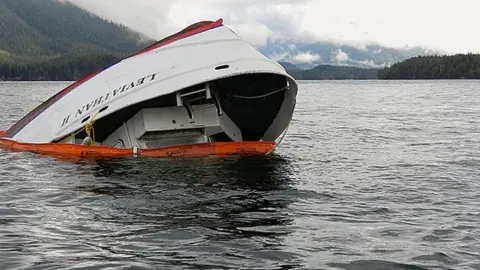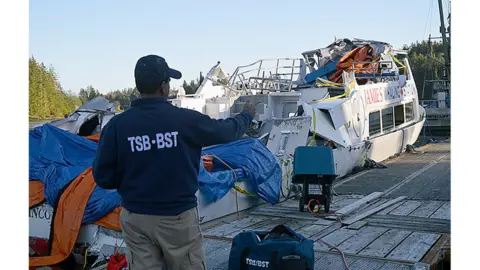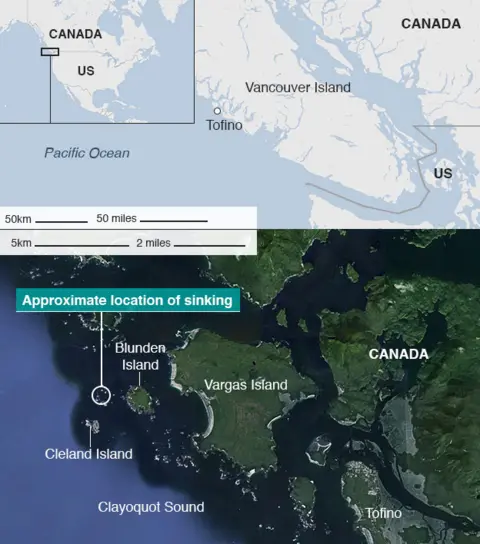Leviathan II whale-watching tragedy caused by breaking wave
 BBC
BBCThe crew of a whale-watching boat tried and failed to avoid a large breaking wave that sank the vessel, killing six off the Canadian coast.
Five Britons were among those who died when the the Leviathan II capsized near Tofino, British Columbia, in 2015.
The Transportation Safety Board (TSB) has released a report with guidance on how to prevent such accidents.
They include having tour boat operators do more to manage hazards like the breaking wave that led to the tragedy.
Clinton Rebeiro, who headed the investigation, said the vessel's crew checked weather conditions before departing in October 2015 and found them "acceptable".
Passengers were also given a safety briefing.
 Transportation Safety Board
Transportation Safety Board Once on the south-east side of the Plover Reefs, Leviathan II was operating in an area where the conditions were favourable for the formation of breaking waves.
At about 15:00 local time (22:00 GMT) "the master and the deckhand heard a noise. The master reached for the throttles to turn the vessel and minimise the impact but the wave struck Leviathan II's starboard quarter before his actions could be effective", Mr Rebeiro said.
"It rose up, pivoting uncontrollably on the wave, leaving it beam on, or sideways, to the wave and thus vulnerable to capsizing."
Capsizing took only an instant. Most of the passengers were thrown into the frigid sea water, skidding down the deck and striking objects along the way. Some became trapped underneath the vessel. No one was wearing life-jackets.
"There's no doubt in this case that had the passengers been wearing life jackets or some sort of personal floatation device, it would definitely have helped many who struggled to stay afloat in the water and it might have prevented some of the fatalities," said TSB chair Kathy Fox.
By chance, crew members found a rocket flare and fired it, catching the attention of a nearby First Nations fishing vessel. But search-and-rescue officials only became aware of the accident about 45 minutes after the vessel capsized.
Many of those rescued suffered from shock, seasickness and hypothermia.
Mr Rebeiro said the factors that create breaking waves are complex "and almost impossible to predict" and the TSB report said more than one factor caused the accident.
"We know the conditions there can be challenging even for experienced mariners, " said Ms Fox.
 Courtesy Transporation Safety Board
Courtesy Transporation Safety BoardInvestigators issued three recommendations:
- That tour vessel operators on the west coast of Vancouver Island take steps to identify when and where hazardous waves form and how to avoid them.
- That all commercial passenger vessels - about 4,000 nationwide - adopt explicit risk management processes, and that Transport Canada develop guidelines to better implement and oversee them.
- The mandatory carriage of emergency beacons so authorities are automatically alerted when vessels are in distress.
Transport Canada, the federal transportation department, has 90 days to respond to the report.
In 2016, two German passengers who survived the accident filed a class action lawsuit in British Columbia against the company operating the 20m (65ft) boat, Jamie's Whaling Station and Adventure Centres.
The civil claim alleges the family-owned company was negligent in its operation of the vessel, and that although passengers were told where to find life jackets on the boat, they were never advised to wear them.
On Wednesday, the owner of the company, Jamie Bray, said he will take the TSB recommendations seriously, and has already worked to improve safety on company vessels. That includes adding more personal flotation devices to vessels and incorporating crew recommendations into established safety drills.
In a video statement, Mr Bray said: "That day reminded all of us just how unpredictable the ocean can be, and the tragedy of October 25 will never fade from our memories".

